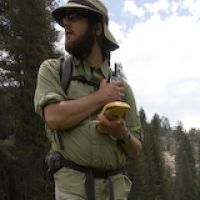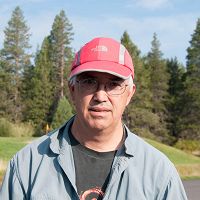Lucas et al., 2011
Physical and biogeochemical controls on polymictic behavior in Sierra Nevada stream pools.
Lucas, R.G., Conklin, M.H., Tyler, S.W., Suarez, F.I., Moran, J.E., Esser, B.K. (2011)
Fall meeting, American Geophysical Union, December 2011, Halls A-C, 8:00 AM. Abstract H51B-1209.
-
Sierra, GRAD STUDENT
-
Sierra, INVESTIGATOR
-
Sierra, COLLABORATOR
Abstract
We observed polymictic behavior in stream pools in a low gradient montane meadow in the southern Sierra Nevada mountains, California. Thermal stratification in stream pools has been observed in various environments; stratification generally persists where the buoyancy forces created by a variation in water density, as a function of water temperature, are able to overcome turbulent forces resulting from stream flow. Because the density gradient creates a relatively weak buoyancy force, low flow conditions are generally required in order to overcome the turbulent forces. In some studies, a cold water source in to the pool bottoms can help to increase the density gradient and perpetuate thermal stratification. Our study took place in Long Meadow, Sequoia National Park, California. Long Meadow lies in the Wolverton Creek watershed and is part of the Southern Sierra Critical Zone Observatory. The 1-4 m diameter and 1-2 m deep pools in our study stratified thermally during the day and mixed completely at night. The low gradient of the meadow provided low stream flows. Piezometers in the meadow indicated groundwater discharge into the meadow in the months during which stratification was observed. Radon 222 activity measured in the pools also indicated groundwater influx to the pool bottoms. We used Fluent, a computational fluid dynamics equation solver, to construct a model of one of the observed pools. Initially we attempted to model the physical mechanisms controlling thermal stratification in the pool including stream flow, groundwater discharge, solar radiation, wind speed, and air, stream and ground water temperatures. Ultimately we found the model best agreed with our observed pool temperatures when we considered the light attenuation coefficients as a function of the dissolve organic carbon (DOC) concentration. Elevated DOC concentrations are expected in low stream flow regimes associated with highly organic soils such as a montane meadow. DOC concentrations measured in samples collected from the meadow stream, pools, and ground water wells ranged from 3.09 to 5.25 mg/L. We used a power equation taken from the literature to vary the visible light attenuation with DOC values measured in the meadow system. Light attenuation coefficients determined from measured DOC concentrations ranged from 0.507 m-1 to 0.899 m-1. The results from our modeling efforts indicate that in low flow streams and rivers elevated concentrations of DOC can increase the potential for thermal stratification in stream pools.
Citation
Lucas, R.G., Conklin, M.H., Tyler, S.W., Suarez, F.I., Moran, J.E., Esser, B.K. (2011): Physical and biogeochemical controls on polymictic behavior in Sierra Nevada stream pools. Fall meeting, American Geophysical Union, December 2011, Halls A-C, 8:00 AM. Abstract H51B-1209..
Explore Further



